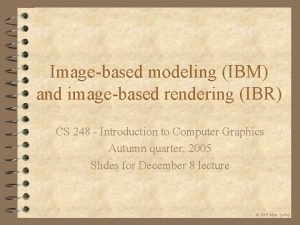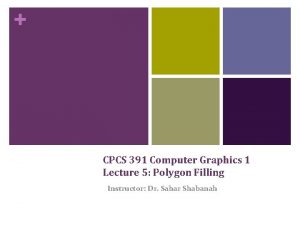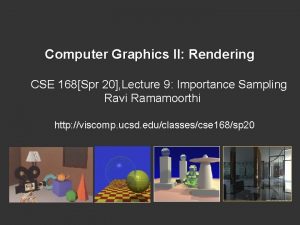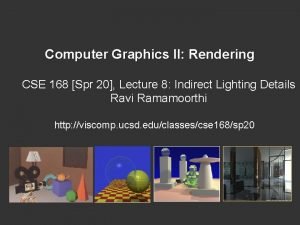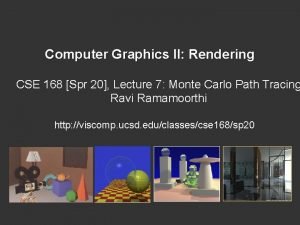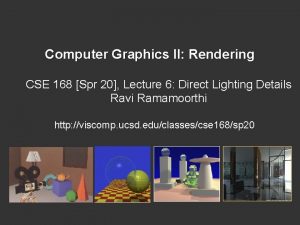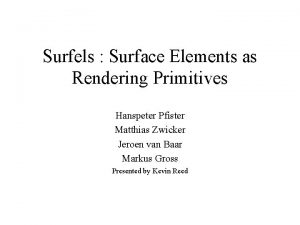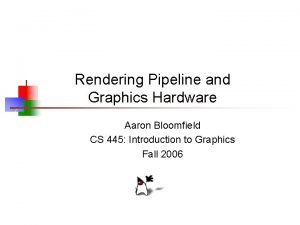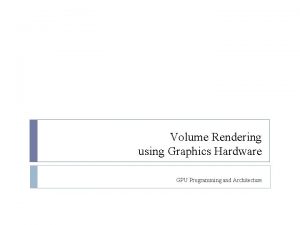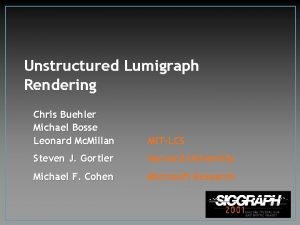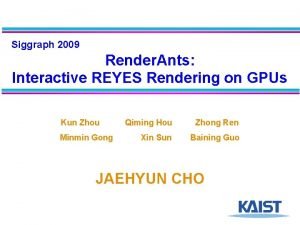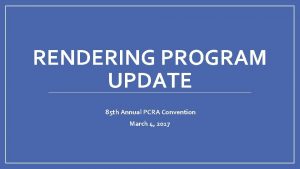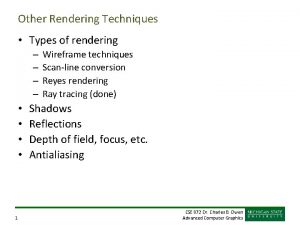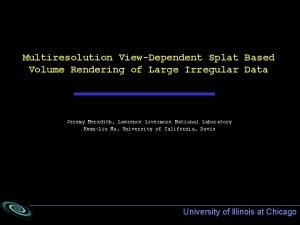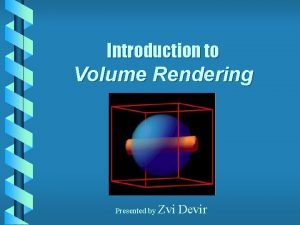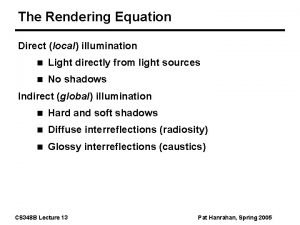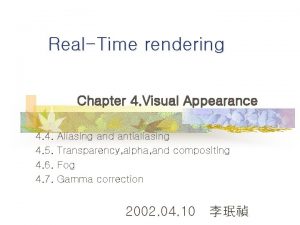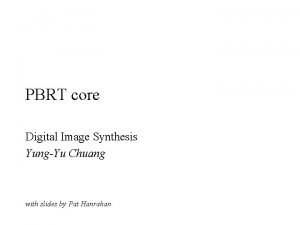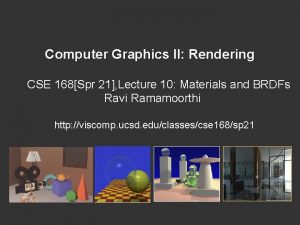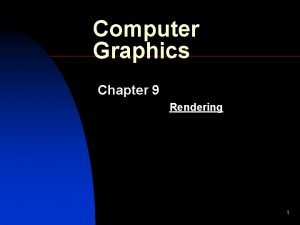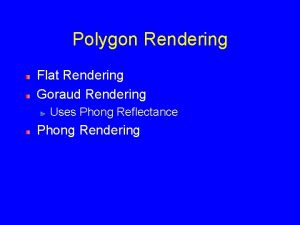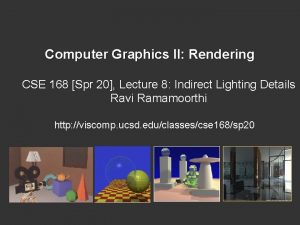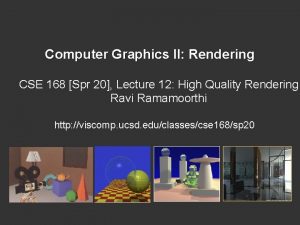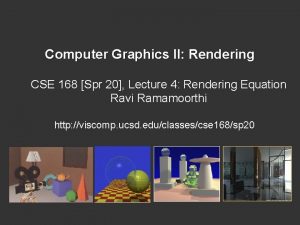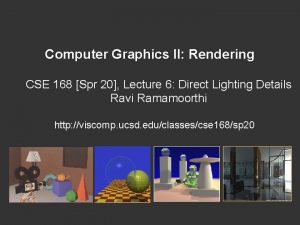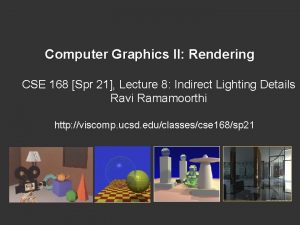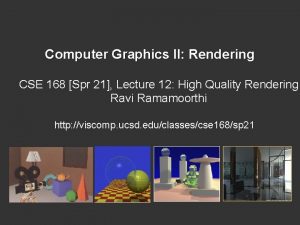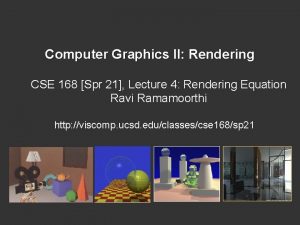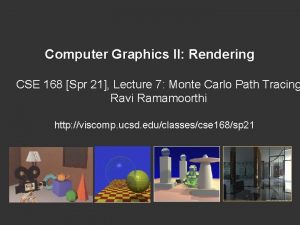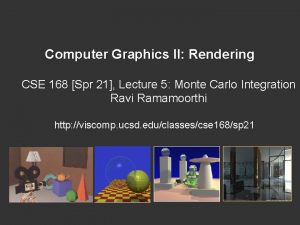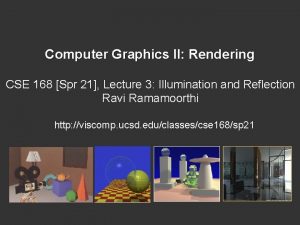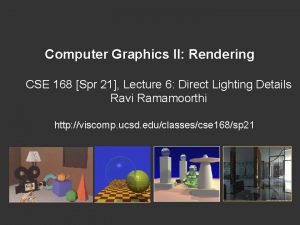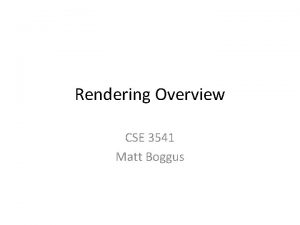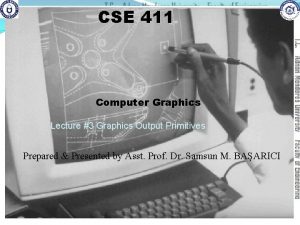Computer Graphics II Rendering CSE 168Spr 21 Lecture
![Computer Graphics II: Rendering CSE 168[Spr 21], Lecture 9: Importance Sampling Ravi Ramamoorthi http: Computer Graphics II: Rendering CSE 168[Spr 21], Lecture 9: Importance Sampling Ravi Ramamoorthi http:](https://slidetodoc.com/presentation_image_h2/1a8c10ef06bd21e13c9895b0a554c888/image-1.jpg)





























- Slides: 30
![Computer Graphics II Rendering CSE 168Spr 21 Lecture 9 Importance Sampling Ravi Ramamoorthi http Computer Graphics II: Rendering CSE 168[Spr 21], Lecture 9: Importance Sampling Ravi Ramamoorthi http:](https://slidetodoc.com/presentation_image_h2/1a8c10ef06bd21e13c9895b0a554c888/image-1.jpg)
Computer Graphics II: Rendering CSE 168[Spr 21], Lecture 9: Importance Sampling Ravi Ramamoorthi http: //viscomp. ucsd. edu/classes/cse 168/sp 21

To Do § Start working on homework 3. Ask me if problems § Also homework 4. This lecture covers material (Lecture is designed to follow assignment closely) § Start thinking about final project

Importance Sampling § Talked about in Monte Carlo Path Tracing § This assignment: implement at each bounce § Use “good” pdf for sampling instead of uniform § Extension to Multiple Importance Sampling (Veach 95) § Allows considering both lighting and BRDF sampling § Key development in production rendering (Academy Award) § Remains active topic of research (many papers in 2019)


Cosine Importance Sampling § Include cosine term in PDF (for indirect lighting) § Previously, uniformly integrate over hemisphere § Now, consider a cosine PDF

Cosine Sampling Upper Hemisphere § Inversion method § In polar coords, density must be proportional to cos θ sin θ (remember d(solid angle) = sin θ dθ dϕ) § Integrate, invert cos-1(sqrt(…)) § Recipe is (start with two random numbers ξ 1, ξ 2 in 0… 1) § § Generate ϕ in 0. . 2π ϕ=2πξ 2 Generate z in 0. . 1 z=sqrt(ξ 1) // Note extra sqrt wrt uniform Let θ = cos-1 z θ=acos(z) = acos(sqrt(ξ 1)) (x, y, z) = (sin θ cos ϕ, sin θ sin ϕ, cos θ ) § Rotate according to surface normal (z goes to normal) § Or create coordinate frame (as you did for uniform sampling) § Modify indirect lighting estimator (remove ) and replace 2π with π (indirect lighting, Russian Roulette)

Uniform Hemisphere Sampling

Cosine Sampling

Specular BRDFs § Cosine importance sampling works well for near. Lambertian BRDFs (modest improvement) § But more sophisticated sampling for specular BRDFs § Will talk about general BRDFs next lecture § For now, for assignment: Modified Phong, GGX § Sampling BRDFs in general is non-trivial § Can simply normalize to get PDF, but sampling non-trivial § For now, sample a simpler BRDF, then divide by PDF § (This procedure is always guaranteed to work)

BRDF Importance Sampling § Phong BRDF: fr ~ cossβ where β is angle between outgoing ray and ideal mirror direction § Constant scale = ks(s+2)/(2π ) § Can’t sample this times cos θ i § Can only sample BRDF itself, then multiply by cos θ i § That’s OK – still better than random sampling

BRDF Importance Sampling § Recipe for sampling specular term: § § Generate z in 0. . 1 Let γ = cos-1 (z 1/(s+1)) Generate ϕγ in 0. . 2π This gives direction w. r. t. ideal mirror direction § Convert to (x, y, z), then rotate such that z points along mirror dir.

Formal Modified Phong Sampling § Multiply by cosine, transport function (note colors) § Modified Phong is an approximation § Generate 3 random numbers: ξ 0, ξ 1, ξ 2 in 0… 1 § Use ξ 0 to decide diffuse (>t) or specular (≤t) § Generate ϕ in 0. . 2π ϕ=2πξ 2 § If diffuse θ= acos(sqrt(ξ 1)) [coord. frame normal n] § If specular θ= acos(ξ 11/(s+1)) [coord. frame refl r] § Compute BRDF / PDF (if below visible, BRDF = 0)

Without BRDF Importance Sampling (note near-mirror sphere)

With BRDF Importance Sampling (note near-mirror sphere)

GGX Microfacet Model § Physically-Based Reflectance Model § Widely used in practice § Will discuss BRDFs in more detail next time § Brief review here, see assignment for details

Experiment

Fresnel Reflectance

(Cook-)Torrance-Sparrow § Assume the surface is made up grooves at the microscopic level. (General Microfacet Theory) § Assume the faces of these grooves (called microfacets) are perfect reflectors. § Take into account 3 phenomena Shadowing Masking Interreflection

(Cook-)Torrance-Sparrow Fresnel term: allows for wavelength dependency How much of the macroscopic surface is visible to the light source Geometric Attenuation: reduces the output based on the amount of shadowing or masking that occurs. How much of the macroscopic surface is visible to the viewer Distribution: distribution function determines what percentage of microfacets are oriented to reflect in the viewer direction.

GGX Microfacet Model § Specular term (see assignment for G, F) § Importance Sampling PDF (includes cosine term) § Neglects F and G terms, must do BRDF / PDF § Note that t is clamped at a min of 0. 25 to give some specular samples even for low ks (because of Fresnel)

Importance Sampling GGX § High-Level idea similar to modified Phong § Generate 3 random numbers: ξ 0, ξ 1, ξ 2 in 0… 1 § Use ξ 0 to decide diffuse (>t) or specular (≤t) § Generate ϕ in 0. . 2π ϕ=2πξ 2 (if specular, this is ϕh) § If diffuse θ= acos(sqrt(ξ 1)) [coord. frame normal n] § If specular [coord. frame halfvector h] § Must compute incident direction from outgoing, half-vector § Rotate h about normal, reflect outgoing about half-vector § Compute BRDF / PDF (if below visible, BRDF = 0)

Multiple Importance Sampling § Veach 95 classic scene (4 lights, 4 glossiness) § BRDF importance sampling only (no NEE, so no explicit direct lighting or light sampling pass) § Mostly noisy but sharper reflections handled well § Compare with light sampling (NEE) § Mostly better but noisy for sharp reflections § Can we combine BRDF, Light(NEE) sampling? § § MIS (Veach 95) provides a way, bounds Very robust, works well shiny/rough etc. Key development in production rendering Remains topic of interest (many papers in 2019)

Multiple Importance Sampling BRDF Importance Sampling (note top right images)

Multiple Importance Sampling Light Sampling (Next Event Estimation for Direct Lighting)

Multiple Importance Sampling (NEE+BRDF Sampling)

Multiple Importance Sampling § MIS relies on NEE almost everywhere, but relies on BRDF importance sampling when needed § Multi-sample: sample both distributions at each intersection § General case: N sampling techniques (inner summation is unbiased estimator each technique) § Weights must sum to 1, unbiased

Multiple Importance Sampling § General case: N sampling techniques (inner summation is unbiased estimator each technique) § Weights must sum to 1, unbiased § Interesting theory (ongoing, papers in 2019) § Veach and Guibas 95 proposed balance, power heuristics (provably “good” under certain assumptions) § We use power heuristic with β = 2 § Subtle point: PDF must be able to be evaluated anywhere (not just own samples) § Natural abstract interface for sampling and MIS § Eval(), Sample(), PDF() [sometimes Value() = Eval/PDF]

Lighting/BRDF Sampling § For now, 1 sample on light (NEE), 1 from BRDF § We already know BRDF PDF § Light PDF implicitly on light, convert to angle § For multiple lights, simple normalization (see homework) § Combine NEE and BRDF sampling (power heuristic)

MIS Implementation § Can be tricky, see assignment § First disable NEE, BRDF sampling for direct § Separate NEE function, toggle light/BRDF sampling § Now implement pdf(nee) § Beware divide by zero, see assignment for specifics § Implement weight function § Visualize weighted lighting, weighted BRDF § Then combine them with MIS, enable both techniques § See assignment carefully § MIS for direct lighting only (Veach scene no indirect) § Note gamma correction for this assignment

MIS weights Weighted contribution BRDF Importance Weighted contribution of NEE
 Computer graphics pipeline
Computer graphics pipeline Forma urbis
Forma urbis Graphics rendering
Graphics rendering Graphics monitor and workstation in computer graphics
Graphics monitor and workstation in computer graphics Graphics hardware in computer graphics ppt
Graphics hardware in computer graphics ppt 168spr
168spr Cse 168
Cse 168 Cse 168
Cse 168 168spr
168spr 01:640:244 lecture notes - lecture 15: plat, idah, farad
01:640:244 lecture notes - lecture 15: plat, idah, farad Computer security 161 cryptocurrency lecture
Computer security 161 cryptocurrency lecture Computer aided drug design lecture notes
Computer aided drug design lecture notes Computer architecture notes
Computer architecture notes Microarchitecture vs isa
Microarchitecture vs isa Arsir gradasi adalah
Arsir gradasi adalah Hanspeter pfister
Hanspeter pfister Camera translate
Camera translate Bunkasha games
Bunkasha games Jerry tessendorf
Jerry tessendorf Michael buehler
Michael buehler Reyes rendering
Reyes rendering Photorealistic rendering carlsbad
Photorealistic rendering carlsbad Clustered shading
Clustered shading Shadow rendering techniques
Shadow rendering techniques Splat rendering
Splat rendering Introduction to volume rendering
Introduction to volume rendering Car paint rendering
Car paint rendering Windows color system
Windows color system Rendering equation
Rendering equation Rendering realtime compositing
Rendering realtime compositing Kajiya rendering equation
Kajiya rendering equation

